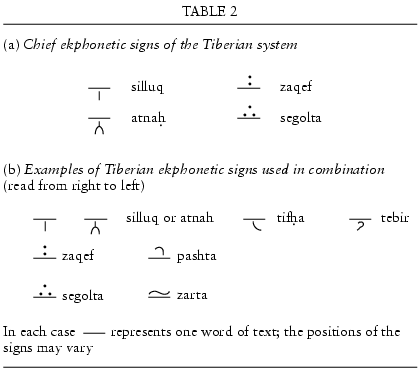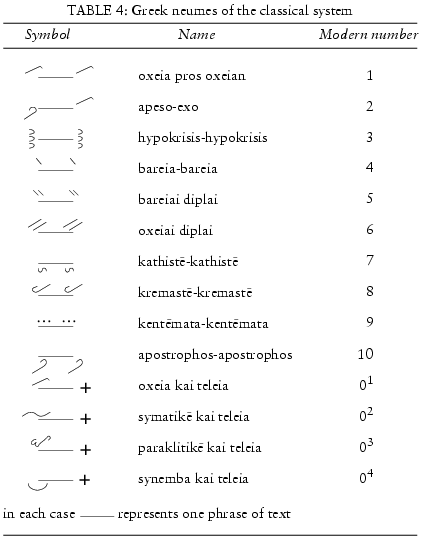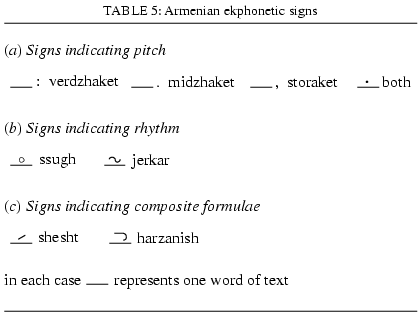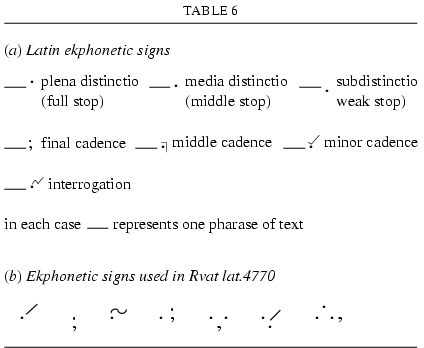
Notation designed to facilitate the solemn cantillation of lessons, especially of biblical texts. The term ‘ekphonetic’ (from Gk. ekphōnēsis: ‘pronunciation’, ‘reading aloud’) was coined by I. Tzetzes in 1885 (‘Hē epinoēsis tēs parasēmantikēs tōn Buzantinōn’, Parnassos, ix, 1885, p.441). Various such systems may be found in medieval manuscripts; in no case is the musical significance of the signs known, and hypothetical transcriptions are possible only by comparison with cantillation in the modern practice of the various traditions. The signs may comprise letters, dots or ‘cheironomic’ figures which presumably represent the motions of a conductor’s hand; these signs are termed ‘accents’ in the Semitic systems and ‘neumes’ in the Latin and Greek, although their significance is not that of the neumes in Western and Byzantine neumatic notations (see Notation, §III, 1 and Byzantine chant, §2) and the types should not be confused. Ekphonetic notation occurs mainly in association with biblical texts, whether for church or synagogue, but may be found also in other prose texts and even in hymns.
1. Syriac, Pehlevi and Soghdian.
4. Slavic, Georgian and Armenian.
GUDRUN ENGBERG
Dots are often found in Syriac manuscripts of the Bible, written in black ink above, below or on the line. In other texts they appear less frequently and in red, perhaps to indicate that their use in this way is unusual. They served to facilitate a correct understanding of the sacred text, and to indicate the inflections of the voice; according to Gregory bar-Hebraeus (13th century; ed. and trans. in Moberg, ii, 108–9): ‘In every language a listener can distinguish aurally various meanings in one and the same phrase … merely through changes in inflection; Syrian writers … devised a system and constructed signs consisting of dots for the accents, so that the various inflections, each of which indicated a particular meaning, could be understood visually by the reader in the same way as they are recognized aurally by the listener’. Earlier treatises associate the accents with the translation of the Bible from Greek. These treatises contain lists of accents, with examples from the Bible and comments on their use and significance (e.g. to express astonishment or fear).
According to tradition, Joseph Hūzāyā (fl c530) of the school of Nisibis invented the nine main accents, but two of them (pasoqa, main pause, and ‘esyana, subsidiary pause) occur frequently in a manuscript dating from 411. During the 5th century the system increased in complexity; it had developed fully before the 11th century. More than 30 accent names are known, but all except 12 to 15 denote special functions of the main signs. Originally the system seems to have consisted entirely of single dots; later these were combined with the main pausal accent, the pasoqa, as signs containing two dots, which superseded the single dots as indicators of the main divisions within verses. The signs containing two dots were in their turn again combined with the pasoqa, as signs containing three dots (Table 1).

After the schism of the 6th century (see Syrian church music, §1), the Syriac tradition bifurcated into a Western (Syrian Orthodox, Jacobite) tradition whose centre was at Edessa, and an Eastern (Assyrian, Nestorian) tradition whose centre was at Nisibis. New accents were added to the Western tradition, and James of Edessa (d c700) invented nine new variants of existing signs. In practice, however, the notation was reduced to a mechanical application of four pausal accents and other interrogative accents.
The Eastern Syriac notation was supplemented with many additional signs; it became highly sophisticated, and remained more flexible than the Western system. In it, the accents were usually larger than other dots used in the text, in order that the reading should be facilitated (fig.1). Red ink was used to indicate variant readings. The high degree of sophistication of this notation may be seen in the Mar Babai manuscript, dating from 899 and containing elaborate interlinear corrections and variants.
A 6th- or 7th-century Pehlevi psalter (ed. in Andreas and Barr) contains ekphonetic notation identical with that of early Syriac manuscripts. New Testament manuscript fragments from Turfan, in the Soghdian language and written in Nestorian Syriac characters (fig.2), contain Eastern Syriac accents (Table 1b); the corresponding passage is similarly subdivided in Greek manuscripts with ekphonetic notation.
The Tiberian system of notation is the best studied, although some scholars still maintain that it was purely syntactical rather than musical. According to tradition it was invented in the 9th century ce by the family of Ben-Asher at Tiberias, and superseded the Babylonian and Palestinian systems of notation, which are thought to have developed around the early 7th century ce. It is still in use: one system is used for the poetical books of the Old Testament (Psalms, Proverbs and parts of Job), one for the rest of the Bible (see below), a third for rabbinical texts.
The verse is the basic unit of passages of the Bible and is marked off by an accent, silluq, and a punctuation sign, sof-pasuq. Each word of the verse has an accent, serving to join it to or divide it from the next. The signs, placed over or under the line, are dots or strokes, perhaps cheironomic in origin: some Egyptian and Tunisian communities still accompany the cantillation of the Bible with hand movements (see Cheironomy, §4). Final clauses of lessons are not notated, perhaps because the text was divided differently at different times into one-year and three-year cycles; the final words are recited differently from the rest of the lesson only in some communities.
There are 13 dividing accents; Table 2a shows the most important (silluq at the end of a verse, atnah at the end of a half-verse, zaqef and segolta as subsidiary stops within either half of the verse). The sequence of signs is not arbitrary: silluq or atnah is preceded by tifha or tebir; zaqef is preceded by pashta; segolta is preceded by zarqa (Table 2b). The chief dividing accents correspond in equivalent texts to a certain extent with Greek notational signs, but the correspondences may be due to the fact that the Greek translations are parallel in syntax to the Hebrew, rather than to musical similarities between the traditions (Table 3).
In the modern tradition, the accents may be interpreted differently in different parts of the Bible (e.g. Pentateuch and Prophets) or on different occasions (e.g. for cantillation at synagogue or in the heder, the religious school). Although accent lists (lu’ah zarqa) exist, comparable to those of the Greek tradition, where each accent is given its musical value, these do not remain constant in different contexts nor a fortiori within different Jewish communities; and no original interpretation, common to different traditions, can be reconstructed. (See also Jewish music, §III, 2(ii)).

Byzantine ekphonetic notation occurs in manuscripts between the 9th and 14th centuries, and occasionally in later additions to early manuscripts such as the 5th-century Codex Ephraimi (F-Pn gr.9). After the 15th century the function of the signs had been forgotten, and their significance was sometimes misinterpreted as that of punctuation. They occur almost exclusively in biblical texts: the prophetologion (Old Testament lectionary), evangeliarion (Gospel lectionary) and apostolos (Epistle lectionary). They do not occur in the psalter or prose liturgical texts apart from those of the lectionaries, although synod texts in GB-Ob Holkham 6 are provided with ekphonetic notation for liturgical use. Study of Byzantine notation began in the mid-19th century, but the first systematic analysis was that of Høeg (1935). The recitation of lessons in the modern Greek Orthodox Church has not been systematically compared with the medieval notation.
Medieval manuscripts contain continuous lists of neume names, with notation added to the lists as it would be to a biblical lesson. The 10th- or 11th-century manuscript ET-MSsc Monastery of St Catherine 8 has such a list, added in what may be a late 12th-century hand, with ekphonetic notation in red as well as an archaic Palaeo-Byzantine notation (see Byzantine chant, §3) in black, which shows the musical significance of each combination of ekphonetic signs (fig.3). Unfortunately this archaic notation is impossible to transcribe precisely in isolation. Some of the neume names derive from the names of the ancient Greek prosodic accents (oxeia = ‘acute’, bareia = ‘grave’); the apostrophos may represent the hypodiastolē, a prosodic sign of the grammarians of antiquity. The remaining neume names may be cheironomic in origin.

The classical notational system was fully developed between the 11th and 14th centuries with a series of stereotyped neume pairs (Table 4). These signs are written in red above, below or between the phrases of the text as in fig.3, and are combined in pairs so that each pair frames a kolon (unit of three or four words), which is to be recited to a particular musical phrase. The signs at the beginning and end of the kolon are normally identical, except in the apesō-exō pair and those including a teleia. According to the neume list in fig.3, the first and last accented syllables of a kolon are subject to melismatic treatment, and the rest are recited to a simple tonus currens. In the fully developed system, a kolon with the combination syrmatikē and teleia was also marked by a melisma near the end, indicated by a media.

In the classical system, three or four kola are usually linked as a period, the cadence of which is one of the teleia combinations; within the period, intermediate cadences are indicated with the apostrophos (no.10 in Table 4). The whole biblical lesson normally comprises about 15 periods, and concludes with a stereotyped final cadence, consisting of the neume pairs nos.5, 9 and 10, sometimes preceded by pair no.6; nos.6 and 5 occur only in this final cadence.
The archaic ekphonetic notation differs in a number of respects from this classical system: other neume combinations are possible, one neume of a pair may be omitted, the pairs nos.6 and 5 may occur outside final cadences, and in some manuscripts the ekphonetic signs are written in the same brown ink as the text. The melodic formulae must originally have been transmitted orally and applied to the text, from memory, according to the punctuation: the latter, in early manuscripts, comprises dots for short stops and spaces for longer (‘full’) stops. It would seem that when the notation was invented, perhaps in the 8th century, it could at first be used freely, but was then codified by some authority, perhaps at Constantinople.
The Byzantine ekphonetic notation, like the Byzantine neumatic notation, was adopted by the Slavs. A few New Testament manuscripts contain a system of ekphonetic notation; in one source (the Kuprianovskie listki) the notation agrees with that of Greek manuscripts. A Glagolitic missal from Kiev contains eight signs interpreted by some as Latin ekphonetic neumes and by others as prosodic accents. Georgian manuscripts from the 11th to 13th centuries contain lists of neumes transliterated from Greek; the Greek notation may have been used in Georgian lectionaries. Armenian manuscripts contain an indigenous ekphonetic notation, used for the recitation of the Gospel and the Old Testament Prophets. Some of the signs indicate pitch: verjaket, marking a main pause and raising of the voice; midjaket, marking a secondary pause and lowering of the voice; storaket, also marking a secondary pause; and buth, indicating the lowering of the pitch by degrees, without a pause. These are used together with rhythmic signs (sugh, for a shortening of the note, and jerkar, for a lengthening of the note) and signs indicating formulae (shesht and harzanish) (Table 5). Special formulae, not written down, are used at the beginning and end of lessons.

Between the 10th and 15th centuries, a heterogeneous jumble of ekphonetic notational systems was used in Latin lectionaries, sacramentaries, missals, homiliaries and other books, for biblical lessons and also for collects (prayers), other chanted prose sections of the services and homilies. The system used varies between manuscripts but each manuscript normally contains three or four (sometimes many more) signs comprising dots and neumes illustrating the inflection of the voice.
Many manuscripts use neumes in conjunction with the ancient punctuation signs, a dot above the line (plena distinctio, full stop), a dot on the line (media distinctio, middle stop) and a dot below the line (subdistinctio, weak stop). The full stop is combined with the apostrophus to signify a final cadence, and with a quilisma to signify a question; the middle stop, together with the flexa, signifies a middle cadence; the weak stop, together with the flexa, pes or podatus signifies a weaker division (Table 6a). These signs occur after each section of the text, like punctuation marks, and they may be no more than that in the simpler versions of the system that use only two signs. Some manuscripts use these punctuation marks doubled, trebled or quadrupled as in the Syriac systems of ekphonetic notation, but still combined with neumes. I-Rvat lat.4770 contains the signs shown in Table 6b, for example. Biblical texts are subdivided with these signs in a way similar to that of Byzantine ekphonetic notation.

Single words and passages within texts may sometimes carry neumes in the usual sense (i.e. full musical notation rather than ekphonetic notation) over each syllable. This may occur in the title of a lesson, or in its last few words (compare the Byzantine final cadence formulae). In the Passions the words of Christ on the cross may be fully notated with neumes; similar treatment is sometimes given to the genealogies from Luke and Matthew (see Gospel, §3, (ii)–(iv) and Passion, §1). Some manuscripts similarly prescribe a performance of the biblical canticles more solemn than that of the surrounding text.
See also Inflection.
P. Wagner: Einführung in die gregorianischen Melodien, ii: Neumenkunde (Fribourg, 1905, 2/1912/R), 82ff [Latin]
F.W.R. Müller: ‘Neutestamentliche Bruchstücke in soghdischer Sprache’, Sitzungsberichte der Berliner Akademie der Wissenschaften 1907
A. Moberg, ed.: Le livre des splendeurs (Lund, 1907; Eng. trans., 1924) [Syriac]
F.C. Andreas and K. Barr: ‘Bruchstücke einer Pehlevi-Übersetzung der Psalmen’, Sitzungsberichte der Preussischen Akademie der Wissenschaften: philosophisch-historische Klasse (1933)
C. Høeg: La notation ekphonétique, MMB, Subsidia, i/2 (1935)
C. Høeg, G. Zuntz and G. Engberg, eds.: Prophetologium: lectiones anni mobilis, MMB, Lectionaria, i (1939–81) [Greek]
E. Wellesz: A History of Byzantine Music and Hymnography (Oxford, 1949, enlarged 2/1961)
R. Palikarova-Verdeil: La musique byzantine chez les bulgares et les russes (du IXe au XIVe siècle), MMB, Subsidia, iii (1953)
J.B. Segal: The Diacritical Point and the Accents in Syriac (London, 1953)
E. Wellesz: ‘Early Christian Music’, NOHM, ii (1954), 1–13
S. Rosowsky: The Cantillation of the Bible: the Five Books of Moses (New York, 1957) [Hebrew]
G. Engberg: ‘Les Credos du Synodicon’, Classica et mediaevalia, xxiii (1962), 293–301 [Greek]
H. Avenary: Studies in the Hebrew, Syrian and Greek Liturgical Recitative (Tel-Aviv, 1963)
G. Engberg: ‘Greek Ekphonetic Neumes and Masoretic Accents’, Studies in Eastern Chant, i, ed. M. Velimirović (London, 1966), 37–49
D. Jourdan: ‘La notation ekphonétique archaïque (Vaticanus gr.2144)’, Ecole pratique des hautes études: section des sciences historiques et philologiques: annuaire (1968–9), 7–60 [Greek]
J. Raasted: ‘Musical Notation and Quasi Notation in Syro-Melkite Liturgical Manuscripts’, Cahiers de l’Institut du Moyen Age grec et latin, no.31 (1979), 11–37, 53–77
E.J. Revell: ‘Hebrew Accents and Greek Ekphonetic Neumes’, Studies in Eastern Chant, iv, ed. M .Velimirović (Crestwood, NY, 1979), 140–70 [Hebrew]
J. Spector: ‘Chant and Cantillation’, Musica judaica, ix (1986–7), 1–21
R. Flender: Der biblische Sprechgesang und seine mündliche Uberlieferung in Synagogue und griechischer Kirche (Wilhelmshaven, 1988) [Hebrew; Byzantine]
R. Flender: ‘Die Entzifferung der massoretischen Akzente und der ekphonetischen Notation: ein Forschungsbericht’, Musikkulturgeschichte: Festschrift für Constantin Floros zum 60. Geburtstag, ed. P. Petersen (Wiesbaden, 1990), 479–90 [Hebrew]
A. Ascrizzi: La musica bizantina in Calabria: un frammento di un evangeliario in notazione ecfonetica conservato presso la Biblioteca communale di Reggio (Palermo, 1990–91)
D. Jourdan-Hemmerdinger: ‘Fonction du chant dans les discours et lectures publiques’, Aspects de la musique liturgique au Moyen Age, ed. C. Meyer (Paris, 1991), 15–42
P. Kannookadan: The East Syrian Lectionary: an Historico-Liturgical Study (Rome, 1991)
S.G. Engberg: ‘Greek Ekphonetic Notation: the Classical and the Pre-Classical Systems’, Palaeo-Byzantine Notations: a Reconsideration of the Source Material, ed. J. Raasted and C. Troelsgård (Hernen, 1995), 33–55